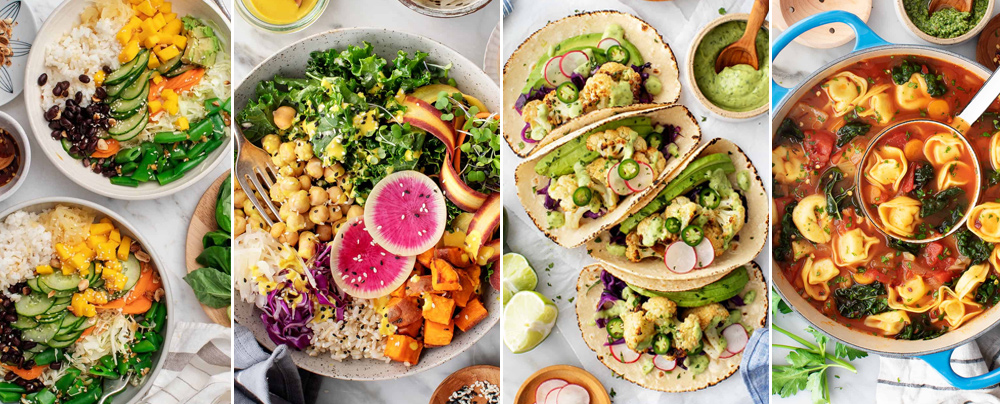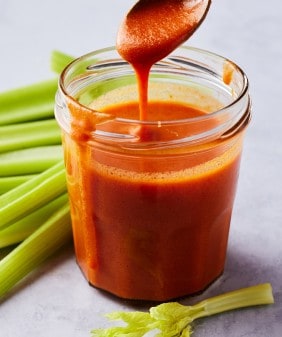Once you start making this homemade pita bread recipe, you won't be able to stop! Soft, puffy, and flavorful, it beats any kind from the grocery store.

This homemade pita bread recipe comes from my friend Molly Yeh. It’s been on my list to try for years, but for one reason or another, I never made it until this spring. When I finally did, what Jack and I thought would be a fun, one-time cooking project turned into a full-on pita bread obsession. We started putting extra yogurt on the grocery list just so we could make it!
If you’re thinking, “Wait. Yogurt? In pita bread?”, you’re not crazy. It’s not a typical pita bread recipe ingredient.
But in my opinion, it’s what makes this pita bread so exceptional. It’s not only thicker, softer, and puffier than any other homemade or store-bought pita I’ve tried, but also it has a tangy, sourdough-like flavor. It’s just as delicious plain as it is with a filling or a dip, and as Molly writes, it’d make a pretty great sleeping bag too. If your experience is anything like ours, once you start making it, you won’t be able to stop.

How to Make Pita Bread
This pita bread recipe is easy to make! Here’s how it goes:
First, make the pita dough. Activate the yeast by mixing it with warm water and a teaspoon of sugar. When the yeast mixture foams, add it to the bowl of a stand mixer fitted with a paddle attachment, and mix it with the flour, salt, remaining sugar, oil, and yogurt. Knead the dough, either with the stand mixer on medium speed or by hand, until it’s soft and slightly sticky, 7 to 10 minutes.

Once you’ve kneaded the dough, let it rise. Transfer it to an oiled bowl and cover it with a kitchen towel or plastic wrap. Set it aside for about 2 hours, or until the dough has doubled in size.

Then, divide the dough into balls. This recipe makes 12 small flatbreads, so you’ll split it up into 12 equal parts. Cover the balls, and let the dough rest for 20 more minutes.

Next, roll out the pita bread! Use a rolling pin to roll the dough balls into 1/4 to 1/2-inch thick circles on a lightly floured surface. Keep any dough you’re not working with covered as you roll out the pita.

Once you’ve rolled out all the dough, bake! Arrange the dough circles on two parchment-lined baking sheets. Bake one sheet at a time at 500°F until the pita bread is puffy and golden brown on top. That’s it! Transfer the freshly baked pita to a wire rack to cool, and enjoy.
Note: When we make this pita bread recipe, there are always a few pita that don’t puff up to form pockets. That’s ok! They’re still great for dipping or enjoying as flatbreads.

Pita Bread Recipe Tips
- Weigh your flour. Because this recipe uses a large amount of flour, you should weigh it if you can. This way, you’ll know exactly how much flour you’re using. Cup measurements are much less precise, as they can vary based on a variety of factors (your specific measuring cups, how tightly you pack your flour, etc.). If you don’t have a kitchen scale, check out this post for my best tips on measuring flour with measuring cups.
- Bake one sheet at a time. Because temperatures vary throughout an oven, bake one sheet at a time for the most even cooking. You don’t want the pita bread on the bottom rack to burn before the top rack starts to brown! And with only one baking sheet in the oven, you can position a rack in the center to give the pita space to puff up.
- Rotate the pan. Jack and I start checking our pita bread a few minutes before we think it’ll be ready, at around the 5 minute mark. At that point, if one side of the pan is more puffy or golden than the other, we rotate it and bake for a few more minutes so that both sides can cook evenly.
- Freeze some for later. Whenever we make this recipe, we almost always freeze half the batch to have on hand for snacking later on. If you plan to store and reheat the pita bread, pull it out of the oven just before it starts to brown. Molly recommends thawing or reheating it in the toaster, where it’ll brown up without getting too crisp or burnt.

Pita Bread Serving Suggestions
This pita bread is so soft, fluffy, and flavorful that we honestly love to eat it plain! However, it’s also fantastic with all sorts of fillings, spreads, and dips. Here are a few ideas to get you started:
- Fill it with falafel, pickled red onions, tahini sauce, and fresh herbs.
- Stuff it with egg salad, vegan egg salad, or my chickpea salad sandwich filling.
- Toast it, slice it into wedges, and add it to a crudité platter with white bean dip and fresh veggies.
- Load it up with my easy chickpea shawarma.
- Use it to scoop up saucy shakshuka or baked feta.
- Pile it with grilled veggies and tzatziki sauce for a light summer meal.
- Top it with peanut butter, sliced banana or apple, and a drizzle of honey.
- Or dip it into hummus, baba ganoush, or muhammara for a healthy snack!
How do you like to eat your homemade pita? Let me know in the comments!

More Favorite Bread Recipes
If you love this homemade pita bread recipe, try making one of these recipes next:


Homemade Pita Bread
Ingredients
- ¾ cup warm water
- 1 package active dry yeast, 2¼ teaspoons
- 1 teaspoon plus 1 tablespoon sugar
- 3¾ cups bread flour, 469 grams, plus more for dusting
- 1½ teaspoons sea salt
- 3 tablespoons extra-virgin olive oil, plus more for the bowl
- ¾ cup whole-milk Greek yogurt
Instructions
- In a medium bowl, combine the water, yeast, and 1 teaspoon of sugar. Let the mixture sit until it’s foamy on top, about 5 minutes.
- In a large mixing bowl or stand mixer fitted with a paddle attachment, combine the flour, salt, and remaining tablespoon sugar. Add the yeast mixture, oil, and yogurt, and mix to combine. Knead the dough, either in the stand mixer on medium speed or by hand on a clean work surface, adding more flour if needed, until it’s soft and slightly sticky, 7 to 10 minutes. Transfer the dough to an oiled bowl, cover with a towel or plastic wrap, and let rise until it’s doubled in size, about 2 hours.
- Preheat the oven to 500°F and line two baking sheets with parchment paper.
- Turn the dough out onto a clean work surface and divide it into 12 equal balls. Cover and let rise an additional 20 minutes.
- Roll the balls out into circles that are ¼ to ½-inch thick. Place them onto the baking sheets an inch apart, then bake, one sheet at a time, until they’re puffy and lightly browned on top. Begin checking at 5 minutes. We bake them for about 8 minutes, rotating the pan after the 5 minute mark if one side of the sheet is puffing up more than the other. Transfer the pitas to a wire rack to cool.














Amazing pitas! My children claimed these to be the best pitas ever! The pockets rose perfectly. All you need is 2.5h and minimum efforts! Thank you for the recipe
Has anyone tried this with regular low-fat Greek yogurt? How would that affect the taste and bread?
Hello, Can the yogurt be left out or is a substitute needed? I don’t do dairy. Thank you
Hi Connie, I think vegan yogurt might work, they just might not puff up the same (they should still be delicious though).
hi Jeanine, love these pitas! ….this time I am needing to stop after getting them all mixed up, and hoping I can put them in the fridge overnight and finish them tomorrow? Thanks for your help!!
Hi Jennie, I’d form the balls through step 4, store them on a baking sheet in the fridge. When you take them out of the fridge, I’d let them rise for 1 hour before baking.
Can I use all purpose flour instead of bread flour for this?
Hi Roshni, yep, you can.
Best pita ever. I used whole sprouted spelt flour with a little extra wheat gluten and a tablespoon of dough conditioner. They’ve come up just perfect and I love the nuttiness of the spelt with the tang of the yogurt. They were perfect for dipping up fresh hot hummus. If I was making them for falafel sandwiches, I’d only make six. These are lovely but doing 12 makes them somewhat small. Definitely will make them again!
I’m so glad you loved them!
How much longer did you cook them when you made the larger size?
We made this to go with our chicken noodle soup, and they were the perfect addition for soaking up the broth and being tasty af. The perfect amount of puffiness – and you could totally use them for pocket pitas too. We also spread a garlic/parsley butter on them and it was perfect!! (I did not have parchment paper so we put them straight on the pan and cooked them for slightly less time)
I’m so glad you loved them!
This is a great recipe. I would just like to add: If you have a pizza stone, the pita will be even better when baked on it. It will be a bit crispier on the outside and soft and fluffy inside.
Thanks for the great tip, Chris!
Do you know how many calories each pita is?